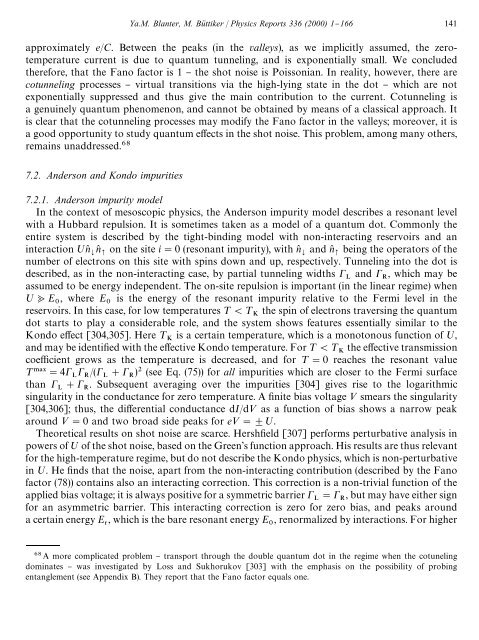shot noise in mesoscopic conductors - Low Temperature Laboratory
shot noise in mesoscopic conductors - Low Temperature Laboratory
shot noise in mesoscopic conductors - Low Temperature Laboratory
Create successful ePaper yourself
Turn your PDF publications into a flip-book with our unique Google optimized e-Paper software.
approximately e/C. Between the peaks (<strong>in</strong> the valleys), as we implicitly assumed, the zerotemperature<br />
current is due to quantum tunnel<strong>in</strong>g, and is exponentially small. We concluded<br />
therefore, that the Fano factor is 1 } the <strong>shot</strong> <strong>noise</strong> is Poissonian. In reality, however, there are<br />
cotunnel<strong>in</strong>g processes } virtual transitions via the high-ly<strong>in</strong>g state <strong>in</strong> the dot } which are not<br />
exponentially suppressed and thus give the ma<strong>in</strong> contribution to the current. Cotunnel<strong>in</strong>g is<br />
a genu<strong>in</strong>ely quantum phenomenon, and cannot be obta<strong>in</strong>ed by means of a classical approach. It<br />
is clear that the cotunnel<strong>in</strong>g processes may modify the Fano factor <strong>in</strong> the valleys; moreover, it is<br />
a good opportunity to study quantum e!ects <strong>in</strong> the <strong>shot</strong> <strong>noise</strong>. This problem, among many others,<br />
rema<strong>in</strong>s unaddressed.<br />
7.2. Anderson and Kondo impurities<br />
Ya.M. Blanter, M. Bu( ttiker / Physics Reports 336 (2000) 1}166 141<br />
7.2.1. Anderson impurity model<br />
In the context of <strong>mesoscopic</strong> physics, the Anderson impurity model describes a resonant level<br />
with a Hubbard repulsion. It is sometimes taken as a model of a quantum dot. Commonly the<br />
entire system is described by the tight-b<strong>in</strong>d<strong>in</strong>g model with non-<strong>in</strong>teract<strong>in</strong>g reservoirs and an<br />
<strong>in</strong>teraction ;n( s n( t on the site i"0 (resonant impurity), with n( s and n( t be<strong>in</strong>g the operators of the<br />
number of electrons on this site with sp<strong>in</strong>s down and up, respectively. Tunnel<strong>in</strong>g <strong>in</strong>to the dot is<br />
described, as <strong>in</strong> the non-<strong>in</strong>teract<strong>in</strong>g case, by partial tunnel<strong>in</strong>g widths and , which may be<br />
assumed to be energy <strong>in</strong>dependent. The on-site repulsion is important (<strong>in</strong> the l<strong>in</strong>ear regime) when<br />
;
















